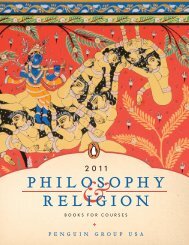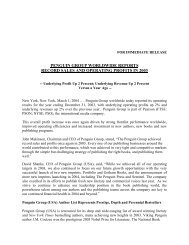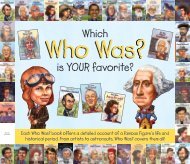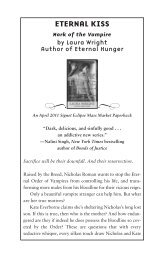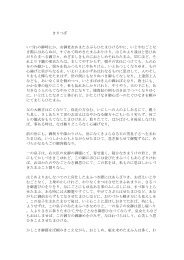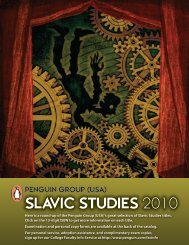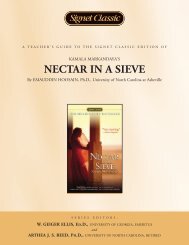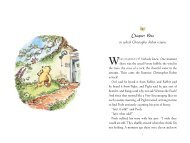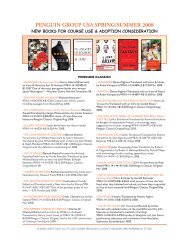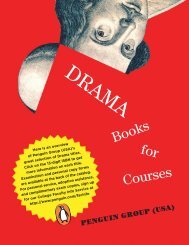Twelfth Night TG - Penguin Group
Twelfth Night TG - Penguin Group
Twelfth Night TG - Penguin Group
You also want an ePaper? Increase the reach of your titles
YUMPU automatically turns print PDFs into web optimized ePapers that Google loves.
A Teacher’s Guide to the Signet Classic Edition of William Shakespeare’s <strong>Twelfth</strong> <strong>Night</strong> 8<br />
realisation that the plays are most appropriately understood and experienced. The consequence for teaching is clear: treat the<br />
plays as plays, for imaginative enactment in all kinds of ways” (p. xii). Consequently, producing the play should be the goal<br />
of the class activities. Students should consider each scene in terms of how it should be spoken and what physical actions<br />
should accompany it. To determine how the lines should be delivered, students should consider what tones and actions<br />
they might use if they were saying a modern version of the words: loud, quiet, angry, loving, upset, shocked, etc. They<br />
should attempt to use those same intonations when reading Shakespeare’s lines. These activities can be done in pairs or<br />
small groups. Students should never be asked to read passages that they have not had the opportunity to prepare.<br />
3. Expecting students both to speak lines and carry out the physical actions that go with them is often to expect too much.<br />
One technique that has been successful in producing a play is to give each role to two students, one to speak the lines and<br />
the other to perform the actions of the character. Scenes that would work well for this approach might be:<br />
Act I: scene iii, scene iv, scene v<br />
Act II: scene iii, scene v<br />
Act III: scene iv<br />
Act V: scene i.<br />
4. The events of the play, while not earth-shattering or tragic, are fairly complex. Directors of TV programs and movies have<br />
chronologies that track the action of what they are directing. One group of students might be asked to serve as recorders<br />
of the action. As the play progresses, they are responsible for recording what has happened — somewhat as the “Overview”<br />
earlier in the guide has done. At the start of each day’s rehearsal, they review the action of the previous day, as they might<br />
for the cast and support staff for a TV show. Then the next act/scene is rehearsed.<br />
5. Characters are very important in all drama, and the characters of <strong>Twelfth</strong> <strong>Night</strong> make the play by their foolish actions, the<br />
love they feel for each other, their romantic dreams, and their relations to each other. One way a director can track the<br />
episodes of the play is to assign one or more staff members to teams to record what a single character said and did and a<br />
description of that character’s mood, feelings, relations to other characters. These reports can be shared with the entire<br />
class each day as they would be with the cast and support staff of a production.<br />
6. The names of the characters in the play carry a great deal of meaning. Students can consider the following question: What<br />
would you think of a person named like these?<br />
Sir Toby Belch — perhaps vulgar, disgusting<br />
Sir Andrew Aguecheek — after looking up “ague” perhaps weak, sickly, twitchy<br />
Malvolio — with a bit of help with “volio” perhaps someone who wishes evil or finds evil because he wishes to<br />
Feste — perhaps festive, causing a festival, lively and ready for a party.<br />
Then students can look for similarly suitable names for the other characters: Sebastian = Braveheart, or Olivia = Aloofisha.<br />
They can surely find better examples. Then they can examine names in the TV programs they’ve been using as reference<br />
points and see if any of the names fit the characters in the same way.<br />
7. To help students visualize the characters, once they have been introduced by the end of Act I, they can look for magazine<br />
pictures that seem close to representing each of the characters as they see them. The collection of pictures of each character<br />
can be gathered together and secured to large sheets of paper. As the reading of the play and consideration of similar<br />
modern drama continues, students can refer to the pictures to help them see the characters as if they were in a TV comedy.<br />
8. Although individual in many ways, the characters in <strong>Twelfth</strong> <strong>Night</strong> are also stock characters. As students observe more<br />
about each character in action, they might try to categorize the characters by reference to characters of the same type in<br />
modern plays. Sir Toby, for example, fits into the category of a slapstick character; the Duke, a lovesick dolt. Examining<br />
how modern versions of these character types are portrayed will, of course, help both in staging the play and in considering<br />
what modern version it might be like.<br />
9. Shakespeare’s language, though wonderful, is a problem for modern young readers. As a part of the production of a TV<br />
show or movie, a task force can be assigned the responsibility of watching for words and expressions that might not be<br />
familiar to the audience. A group of students — especially those interested in language — can be assigned the role of<br />
“Language Watchdogs” to catch such words and expressions, decide how crucial the understanding of them is to the<br />
audience, and suggest alternatives. The task force might also propose replacements, and the class can decide which<br />
replacements would still work in the overall language of the play.




